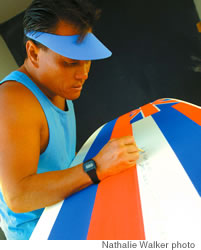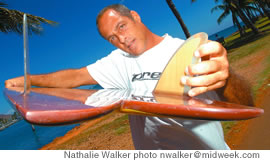The Shape Of Things To Come
After a scare late last year, Hawaii surfboard shapers are finding new sources for foam blanks, and that’s good news for surfers

By .(JavaScript must be enabled to view this email address)
E-mail this story | Print this page | Archive | RSS

Jon Mar: Shape a board based on a
surfer’s abilities
teurs: Sonny Garcia, Andy Irons, John Shimoka, a lot of the kids when they were amateurs. But when they went pro all the big name companies were picking them up. So you do the ground work and they get them after.
Q: What’s your price range?
A: An arm and a leg.
Q: What would you say is your signature look?
A: Two designs that I developed in the ‘70s and it’s never left. It’s gone full circle. It’s a swallowtail, which is a tail that’s designed so the board is a quicker turning tail. And a design called the sting, and that’s a wing which is one-third up the board, which makes the board turns even quicker.
Q: What’s your shaping philosophy?
A: Whatever we are surfing on, the board, the vehicle, whatever we are using in the ocean, it always has to be a combination of natural feelings. The ocean is always trying to say something to you, and the design of the surfboard is always trying to help improve your surfing. All you gotta do is look and listen.
Darren Tatsuno
Contact: 258-9313
Q: What type of boards would you say you are “best” at making?
A: I enjoy making anything from retro, guns, long boards, but I mostly make short boards. Most of my orders are short boards.
Q: Can you describe the process in which you handle someone ordering a custom board?
A: The process I take in taking a custom surfboard order would be I treat every surfer like a team rider. We talk about what he or she is currently riding at the moment, and from there we both decide the changes we should put in the board to improve the surfer’s ability and performance. This was taught to me by Ben Aipa when I used to ride for him back in competition days. I’m actually trying to follow his footsteps.
Q: What makes your boards unique and different from what else is out there?
A: First of all I try to keep an open mind at all times. I’ve surfed professionally for many years on the ASP tour and the Japan pro tour. And I want to use this knowledge of this experience of various types of board designs that fit different waves and surfers.
Q: What is the most difficult thing in shaping to master?
A: Everything! I think it’s a matter of having your own formula and lines to design boards. Everything is trial and error.
Q: Where do you sell your boards?
A: I have my boards at Drift Surf, Tropical Blends, Up and Riding and Japan Rage Corporation, and Florida Mad Dog Surf.

Kent Senatore: 5,453 boards made, and counting
Jon. B. Mar Contact: www.jmarsurf.com Q: How long have you been shaping? A: Close to 20 years.
Q: What would you say is the most difficult aspect of shaping?
A: Well one of the most difficult and important is to identify the person’s ability and make a board that is suited for him.
Q: Who would you say influenced your style of shaping?
A: Wow, there’s a handful of people from Eric Arakawa, and Ben Aipa is a big mentor, I used to work with him at Town & Country. A lot of the California shapers like Al Merrick.
Q: What are your thoughts on the new use of technology and computers to shape boards?
A: I think it’s great. It allows for the consistency. To me, hand shaping is a little more dinosaur. You can do amazing things with (high tech).
Q: How many boards have you shaped?
A: It’s in the thousands. Maybe 15,000 to 20,000. Something like that.
Q: What do you think are benefits of getting a board from a shaper rather than off the rack in a store?
A: I think it’s important for individuals on a learning curve to get equipment that enhances their surfing. And if you get to work with a shaper who is conscientious about surfing and details and keeps records of your boards, then the learning curve is a lot faster and smoother. And you can get boards that are a lot more accommodating to the individual style.
Q: What’s the most expensive board you’ve sold?
A: I’ve sold boards in the $800-$900 range, but it all depends on what they desire.
Kent Senatore Contact: www.toresurfboards.com Q: How long have you been shaping?
A: I started in 1980 and I’ve been doing it on and off all through, but for the last 10 years it’s been my sole source of income.
Q: Boards are a pretty big investment. How does that cost weigh out with boards breaking and dinging?
A: It’s a thing we’ve always faced all along. Like the short boards that I’ve talked about, they only last about three or four months. And even if you haven’t broke them or dinged them the life starts to come out of them. You always hear shapers and surfers talking about the flex of the board.
Q: Who would you say has influenced your style of shaping?
A: Mostly John Carper because I worked for him for three years. But after I go shape for all these guys, Jeff Johnston, Schaper, Denis Pang, Wade Tokoro, Kerry Tokoro, Arakawa. So they all influenced me in one way or another. I basically took the little bits that stuck in my mind and kinda melded them into my own thing.

Kimo Greene:
Three layers of
glass is key
Q: What’s your shaping philosophy?
A: Keep it simple. I could talk until your eyes were spinning about design and you’re all confused, but to me it’s like every new car model that comes out, basically it’s the same car. I just like to be real with people and say, hey, let’s look at what you’re riding and let’s make you something similar to that, unless you don’t like it. It’s not as technical and crazy, and they want you to believe it.
Q: How many boards have you shaped?
A: I know exactly: 5,453. That’s not very many boards for how long I’ve been shaping, so it’s pretty easy for me to keep track of.
Kimo Greene Contact: kimogreenesurfboards.com Q: What board would you say is your specialty?
A: I would say my most popular board is what I call a Honolulu model. It’s good in all kinds of surf, and I can’t even count how many of those I’ve made already.
Q: Who is your main clientele?
A: About 70 percent of my business is all repeat. I really try to take care of my customers, because that’s the basis.
Q: On the average for the everyday surfer, how often do you need to buy a new board?
A: The thing is my customers don’t really buy new boards because their old ones wear out. They buy new boards to try something different. My boards are not the disposable type. I’m the only surfboard manufacturer I know who puts three layers of glass on my boards, so they last for years.
Q: What’s your price range?
A: They go from about $600 to $1,000. Q: What’s your shaping philosophy? A: I think it’s really important to talk to the person you’re making the board for. And I really like having people here when I’m shaping the board because their energy gets put into the board and it makes it their board. It’s really special.
Q: Do you think you need to be a good surfer to shape?
A: Yeah, absolutely. Because if you don’t know how to surf, you can’t fake it when it comes to surfboards. It’s just part of being able to be in the ocean and know what the ocean is doing. The ocean is changing constantly.
Page 2 of 2 pages for this story < 1 2
E-mail this story | Print this page | Comments (0) | Archive | RSS
Most Recent Comment(s):








